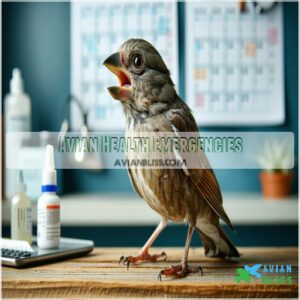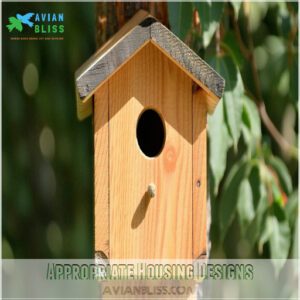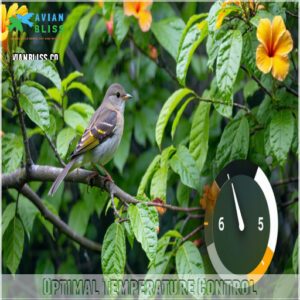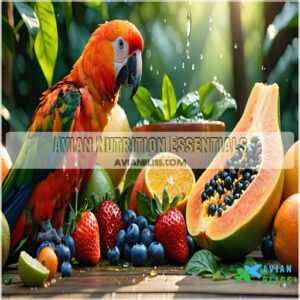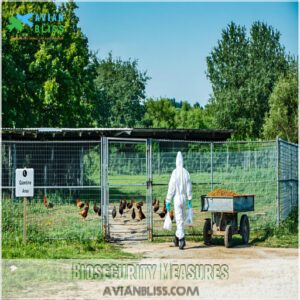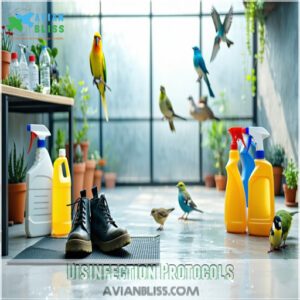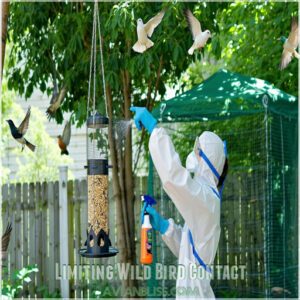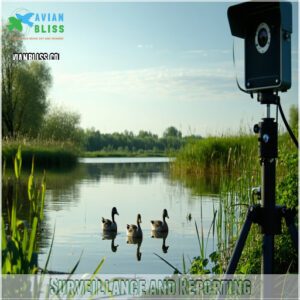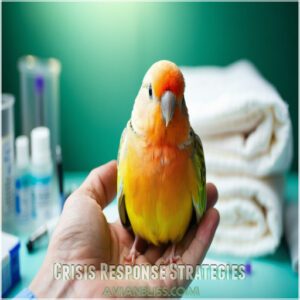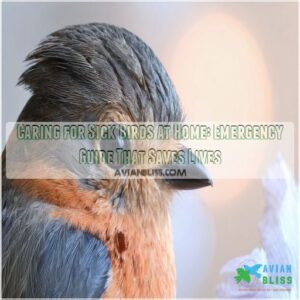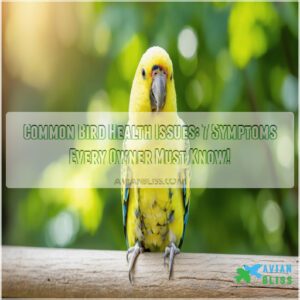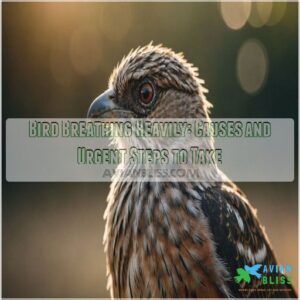This site is supported by our readers. We may earn a commission, at no cost to you, if you purchase through links.
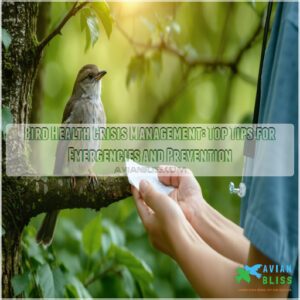
Watch for distress signals like open-mouth breathing, tail bobbing, or sudden lethargy—these might indicate respiratory distress.
For severe bleeding, grab sterile gauze and apply gentle pressure; styptic powder or cornstarch can help stop bleeding. Always have an avian first aid kit handy, including antiseptics like diluted hydrogen peroxide to clean wounds.
Keep your bird calm and warm while you contact a veterinarian.
Prevention matters too—balanced nutrition, clean habitats, and strict biosecurity prevent many emergencies. Stay prepared, and you’ll be ready for anything. Want deeper insights? Keep reading.
Table Of Contents
- Key Takeaways
- Avian Health Emergencies
- Bird Habitat Considerations
- Avian Nutrition Essentials
- Avian Influenza Prevention
- Crisis Response Strategies
- Frequently Asked Questions (FAQs)
- What are crisis receiving & stabilization services?
- Does the United States have a problem with bird flu?
- What should I do if a bird dies?
- How does bird flu affect humans?
- How many birds are affected by bird flu?
- What are the symptoms of the bird flu?
- How many cases of the bird flu in California in 2024?
- How worried should I be about bird flu?
- How long does bird flu last in humans?
- How do you manage bird hormonal behaviors?
- Conclusion
Key Takeaways
- Keep an avian first aid kit ready with essentials like antiseptics, styptic powder, and gauze to handle emergencies quickly.
- Watch for distress signals like tail bobbing, open-mouth breathing, or fluffed feathers, and act fast to stabilize your bird.
- Prevent issues by maintaining clean habitats, offering a balanced diet, and following strict biosecurity measures.
- Contact a veterinarian immediately during a crisis while keeping your bird calm, warm, and restrained.
Avian Health Emergencies
When your bird shows sudden changes like open-mouth breathing or fluffed feathers, it’s a sign something’s wrong.
Quick action can make all the difference in emergencies like respiratory distress or severe bleeding.
Recognizing Distress Signals
Spotting distress signs in birds is essential.
Behavioral changes, like sudden lethargy or unusual vocalizations, often signal trouble.
Subtle shifts, such as fluffed feathers or reduced activity, may indicate an emergency situation.
Regular health monitoring helps with signal recognition.
Quick emergency response is critical for traumatic injuries or illness.
Always assess changes promptly and prepare for avian first aid if needed.
Respiratory Distress Symptoms
Recognizing respiratory distress in birds is essential during an avian health crisis.
Watch for tail bobbing, open-mouth breathing, or lethargy—signs of respiratory failure or air sac disease.
Beak deformities, tracheal issues, or lung infections may also cause distress.
Delayed action can worsen bird health problems.
Prioritize calm handling and immediate veterinary care to address this avian emergency effectively.
For effective management, understanding respiratory disease causes is essential to provide proper care.
Severe Bleeding Response
In emergency situations, quick bleeding control is essential for traumatic injuries. Having an avian first aid kit is important for immediate care.
Follow these steps for effective response:
- Apply gentle pressure with gauze to stop blood loss.
- Use styptic powder, cornstarch, or baking soda for hemostasis.
- For broken blood feathers, pull them carefully and apply pressure.
- Clean wounds with antiseptics like betadine or diluted hydrogen peroxide.
Always monitor closely afterward.
Mental Status Changes
Subtle behavioral alerts like disorientation or head-twisting can signal neurological issues in birds.
Watch for tremors, incoordination, or sudden signs of distress. These stress signs could indicate psychological distress or even trauma.
Determining severity quickly is key in an avian emergency. Affected birds need calm handling and immediate veterinary care to manage neurologic symptoms effectively during a bird health crisis management situation, which requires immediate action.
Bird Habitat Considerations
Creating a safe and supportive habitat guarantees your bird stays healthy and stress-free. Focus on proper housing, temperature control, and enrichment to meet your bird’s physical and mental needs.
Appropriate Housing Designs
After ensuring your bird’s health is stable, let’s focus on creating their perfect home.
You’ll want a birdhouse made from natural cedar wood – it’s naturally cooling and rot-resistant.
The choice of cedar for birdhouses is often influenced by its natural resistance to cedar wood decay.
Keep the design simple: a box shape with a 1.5-inch entry hole and pitched roof works best.
Skip the perch to protect against predators, and remember that bigger holes attract larger birds.
Stress Management Techniques
Your feathered friend’s stress levels can skyrocket from unexpected changes in their environment. By implementing effective stress management techniques, you’ll help your bird maintain peak health.
- Minimize sudden noises by using white noise machines or soft music
- Maintain consistent daily routines for feeding and interaction
- Position the cage away from high-traffic areas and direct sunlight
Watch for stress triggers like unfamiliar visitors or household repairs, and adjust accordingly.
Environmental Enrichment Strategies
Your bird deserves more than just a basic cage setup.
Transform their avian habitat with engaging toys that challenge their natural instincts. Hide treats in puzzle feeders to encourage foraging techniques, or scatter food in different spots to mimic natural feeding patterns.
Rotate toys weekly to maintain interest, and include various textures and sounds for rich sensory experiences.
Social interaction is key – spend quality time playing together daily, fostering a deeper bond through natural instincts and quality time.
Optimal Temperature Control
Just as enrichment keeps your feathered friend mentally sharp, maintaining proper thermal regulation is key to their physical health.
You’ll want to keep room temperatures between 65-80°F, avoiding sudden changes that can trigger heat stress.
Set up a temperature monitoring system and provide cold therapy options like shallow water dishes during hot spells.
Creating a native bird habitat can also support their overall well-being.
Remember, proper climate control directly impacts your bird’s welfare and helps prevent avian health emergencies.
Avian Nutrition Essentials
You’ll need to master your bird’s nutrition basics to prevent health emergencies, just like you wouldn’t feed a marathon runner only candy bars.
Your feathered friend requires a precise balance of nutrients, including the right calcium-to-phosphorus ratio and diverse food sources, to maintain peak health and avoid common diet-related issues.
Balanced Diet Requirements
A proper nutrient balance forms the foundation of your bird’s health.
You’ll need to offer a varied diet that includes fresh fruits, vegetables, high-quality pellets, and occasional seeds.
Dietary supplements should match your bird’s specific vitamin needs and mineral intake requirements.
For ideal avian nutrition, rotate food choices weekly while maintaining consistent portions.
Consider adding sprouted seeds and legumes to boost nutritional variety, ensuring an optimal varied diet.
Calcium-to-Phosphorus Ratio
Your feathered friend’s health depends on getting the right balance of calcium and phosphorus – aim for a 2:1 ratio.
While protein-rich foods and gut acids help calcium absorption, watch out for compounds like phytates that block it.
Boost absorption with vitamin D3, and offer calcium-rich treats like cuttlebone, crushed eggshells, and dark leafy greens.
This perfect mineral balance keeps bones strong and supports healthy egg production.
Electrolyte-Rich Fluids
Maintaining proper electrolyte balance is essential when your feathered friend shows signs of dehydration.
During an avian health emergency, you’ll need to offer oral rehydration carefully. Add a specialized electrolyte solution to clean water – about one teaspoon per cup.
Watch for improvement in their energy levels and droppings. Don’t force-feed fluids; instead, let them drink naturally to prevent aspiration during emergency hydration protocols, ensuring a safe and natural rehydration process.
Diverse Food Sources
How well do you understand your feathered friend’s nutritional needs? Your bird’s health depends on a varied diet beyond basic seeds.
For superior nutrition, consider exploring bird food pellet options. Here are four essential food groups to include:
- Fresh fruits like apples, berries, and melons (remove seeds)
- Quality pellet options fortified with vitamins
- Various seed varieties, focusing on human-grade options
- Nutrient supplements based on species-specific needs
Remember, proper foraging techniques enhance both nutrition and mental stimulation, and it’s crucial to provide a balanced diet.
Avian Influenza Prevention
You’ll need to act fast to protect your birds from avian influenza, a highly contagious virus that’s affected millions of commercial and backyard flocks across the country.
Since wild birds can spread this virus without showing signs of illness, you’ll want to follow strict biosecurity measures.
Including regular disinfection and limiting contact between your domestic birds and wildlife.
Biosecurity Measures
Keeping your birds safe starts with stopping disease spread.
Use bird quarantine procedures for new arrivals and keep enclosures secure to block wild bird access.
Facility security minimizes wildlife disease control risks.
Consistent sanitation protocols and disease surveillance build strong defenses.
Emergency preparedness, like staff training and vaccination strategies during an avian influenza outbreak, maintains effective bird health management, which relies on disease surveillance.
Disinfection Protocols
Disinfecting shoes, cleaning cages, and sterilizing surfaces are your first lines of defense during an avian influenza outbreak.
Use effective disinfectant types, like bleach solutions or veterinary-approved sanitizers.
Regularly apply cleaning methods to feeders and quarantine facilities.
Proper sanitation procedures and virus removal routines stop pathogens from spreading, protecting your birds while aiding wildlife disease control during a bird flu emergency, utilizing effective methods for virus removal.
Limiting Wild Bird Contact
Limit wild bird contact to protect your flock from avian influenza.
Use wild bird barriers like secure netting around enclosures.
Avoid bird feeder safety risks by cleaning feeders weekly.
Outdoor activity precautions include disinfecting shoes and keeping domestic birds indoors.
Backyard bird deterrents, like reflective tape, help reduce disease spread.
Monitor wild bird health closely for potential bird flu emergencies to ensure disease spread is minimized.
Surveillance and Reporting
Bird monitoring keeps outbreaks at bay. Surveillance systems track symptoms like open-mouth breathing or unusual mortality.
Reporting protocols guarantee timely alerts for disease like avian influenza. Use tools for wildlife health monitoring, tracking unusual patterns. Consider avian influenza prevention measures.
Quick disease diagnostics and mortality reporting help protect flocks. Stay updated with health alerts to manage risks and strengthen disease surveillance efforts.
Crisis Response Strategies
When a bird faces a health crisis, swift action can make all the difference.
You’ll need to assess the situation and provide immediate care.
Contact a veterinarian while keeping biosecurity measures in mind.
Assessing Bird Condition
Start with a visual assessment. Observe behavioral cues like lethargy, unusual vocalizations, or fluffed feathers. Physical examination matters—check wings, legs, and breathing.
Analyze droppings for abnormalities. Weight monitoring helps spot silent issues. Determine severity to decide immediate care or stabilizing actions.
First, evaluate carefully before transporting to a veterinarian for professional attention. Early awareness saves lives in emergencies. Recognizing bird shock symptoms, such as weakness and drowsiness, requires understanding of shock warning signs.
First Aid and Immediate Care
When facing bird emergencies, quick action matters. Always have an avian first aid kit ready.
Start by examining the bird and applying gentle restraint. Provide thermal support to stabilize them. Focus on wound care with pressure to stop bleeding. Having proper avian first aid supplies is critical for effective emergency first aid.
- Key items: gauze, cornstarch, antiseptic wipes.
- Bird restraint: use soft towels to avoid stress.
- Emergency kits: essential for immediate care.
Securing Veterinary Assistance
When facing avian emergencies, act fast. Locate an avian veterinarian with proper credentials using reputable directories or referrals from rescues.
Prepare emergency funds or bird insurance for unexpected costs. Remove perches during transport, and choose a secure carrier.
Avian veterinary care requires specialists—verify urgent referrals and clinic expertise to guarantee effective support for your bird’s health. Ensure you have proper credentials to get the best care.
Implementing Biosecurity Plans
When preparing for an animal health emergency, focus on strong biosecurity protocols.
Regular sanitation methods, like disinfecting cages and shoes, stop disease spread.
Spot avian influenza symptoms early with proper bird disease diagnostics.
Infection control includes separating sick birds and monitoring well ones.
Emergency preparedness means updating your space and tools, helping manage foreign animal diseases effectively while safeguarding avian health.
Frequently Asked Questions (FAQs)
What are crisis receiving & stabilization services?
Did you know 70% of emergencies are stabilized within minutes?
Crisis receiving and stabilization services provide immediate support.
These services assess critical needs and maintain safe environments, preventing further harm during mental health, medical, or social emergencies.
Does the United States have a problem with bird flu?
Yes, the U.S. faces a bird flu issue.
Outbreaks impact millions of birds, disrupt poultry farms, and carry risks to human health.
Vigilant biosecurity, disinfection, and monitoring are critical to controlling its spread.
What should I do if a bird dies?
If a bird dies, wear gloves, seal the bird in a plastic bag, and dispose of it in the trash or follow local wildlife reporting guidelines.
Disinfect surfaces and wash your hands thoroughly afterward.
How does bird flu affect humans?
Think of bird flu as a virus hitching a ride to humans.
While rare, it can cause severe symptoms like fever, coughing, and difficulty breathing.
Direct contact with infected birds or surfaces spreads it most, and this can be considered the key factor, so Direct contact is crucial.
How many birds are affected by bird flu?
Over 19 million birds in commercial flocks have been affected by bird flu recently, with wild birds spreading the virus.
This outbreak continues disrupting poultry operations, leading to culls and severe economic and ecological impacts.
What are the symptoms of the bird flu?
Look for signs like respiratory distress, open-mouth breathing, tail bobbing, sudden death, tremors, seizures, or incoordination.
Other symptoms include head-twisting, blue-tinted eyes, and unusual behavior.
Always act fast and contact a veterinarian to address these symptoms.
How many cases of the bird flu in California in 2024?
In 2024, California reported significant bird flu cases, with outbreaks affecting commercial and backyard flocks.
While exact numbers varied, millions of birds were infected, highlighting the importance of biosecurity measures to control the virus’s spread.
How worried should I be about bird flu?
You don’t need to panic about bird flu, but stay alert.
It’s highly contagious among birds, and rare human transmission can happen.
Follow hygiene tips like washing hands after handling birds and avoiding contact with sick flocks.
How long does bird flu last in humans?
Bird flu symptoms in humans typically last about 5 to 10 days, depending on the severity.
Mild cases may resolve quicker, while severe infections could take longer.
Always seek medical care if symptoms persist or worsen.
How do you manage bird hormonal behaviors?
Managing hormonal behaviors is like steering through stormy skies—reduce stimuli by adjusting lighting, limit petting to the head, and provide toys to redirect energy.
Enrich their environment to keep them mentally and physically active, which can be seen as a way to redirect energy and also to enrich.
Conclusion
In dealing with bird health crisis management, preparation truly saves lives.
A minor oversight can snowball into chaos, so always stay alert.
Recognize distress signals early, like labored breathing or unusual lethargy.
Keep your avian first aid kit stocked with essentials like antiseptics and styptic powder.
Prevention is key—focus on clean habitats, balanced diets, and biosecurity measures to minimize risks.
Your quick action and vigilance will make sure your feathered friend stays happy, healthy, and safe.
- https://www.scientificamerican.com/article/eggs-hit-by-bird-flu-crisis-as-farmers-loose-flocks-to-virus/
- https://www.axios.com/2025/02/03/bird-flu-crisis-new-phase
- https://www.rspca.org.uk/adviceandwelfare/wildlife/birds/injured
- https://vcahospitals.com/know-your-pet/common-conditions-of-birds
- https://www.wildlifetrusts.org/wildlife-advice/injured-bird-advice

